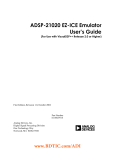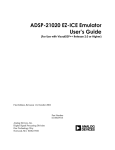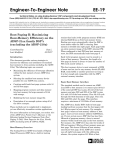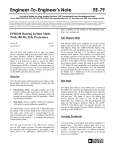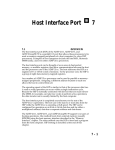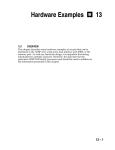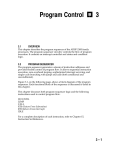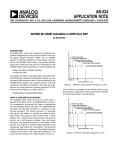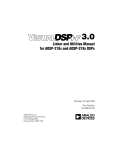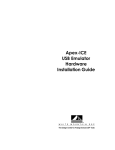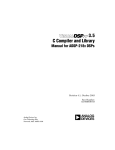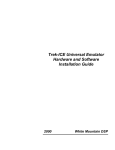Download ADSP-218x Family EZ-ICE Hardware Installation
Transcript
ADSP-218x Family EZ-ICE Hardware Installation Guide 2000 Analog Devices, Inc. ADSP-218x Family EZ-ICE Hardware Installation Guide a Notice Analog Devices, Inc. reserves the right to make changes to or to discontinue any product or service identified in this publication without notice. Analog Devices assumes no liability for Analog Devices applications assistance, customer product design, customer software performance, or infringement of patents or services described herein. In addition, Analog Devices shall not be held liable for special, collateral, incidental or consequential damages in connection with or arising out of the furnishing, performance, or use of this product. Analog Devices products are not intended for use in life-support applications, devices, or systems. Use of an Analog Devices product in such applications without the written consent of the Analog Devices officer is prohibited. Users are restricted from copying, modifying, distributing, reverse engineering, and reverse assembling or reverse compiling the ADDS-218XICE-2.5V operational software (one copy may be made for back-up purposes only). No part of this document may be reproduced in any form without permission. Trademarks are property of their respective holders. Limited Warranty The ADDS-218X-ICE-2.5V hardware is warranted against defects in materials and workmanship for a period of one year from the date of purchase from Analog Devices or from an authorized dealer. Copyright © 2000, Analog Devices, Inc. All rights reserved. Revision 2, May 2000 82-000332-01 i Contents 1. INTRODUCTION ..............................................................................1 2. REQUIREMENTS .............................................................................2 3. CONFIGURATION AND INSTALLATION ....................................3 3.1 INSTALLATION .......................................................................................................3 3.2 CONFIGURING THE ADSP-218X ICE POD .........................................................4 3.3 CONNECTING THE POD TO YOUR TARGET SYSTEM ...................................5 3.4 CONNECTING THE EZ-ICE TO YOUR PC...........................................................7 3.5 SOFTWARE INSTALLATION AND OPERATION ..............................................7 3.6 EZ-ICE MODES.........................................................................................................7 3.6.1 HARD-RESET STATE .....................................................................................7 3.6.2 SOFT-RESET STATE.......................................................................................7 3.6.3 STANDBY MODE............................................................................................8 3.6.4 TRANSPARENT MODE .................................................................................8 3.6.5 EMULATOR SPACE........................................................................................9 3.6.6 USER SPACE...................................................................................................10 4. INITIALIZING THE EZ-ICE ............................................................11 4.1..................... MANUALLY CHANGING SERVER FIRMWARE TO THE EZ-ICE ii 5. SUPPORT ...........................................................................................14 5.1 TECHNICAL SUPPORT ........................................................................................14 5.2 QUALITY ASSURANCE .......................................................................................14 6. REFERENCE .....................................................................................15 List of Figures FIGURE 1. JUMPERS...................................................................................................4 FIGURE 2a. TARGET BOARD EMULATION HEADER ............................................6 FIGURE 2b. EMULATION CONNECTOR ..................................................................6 FIGURE 3. FIRMWARE UPDATE ............................................................................12 iii 1. Introduction Thank you for purchasing the ADSP-218x Family EZ-ICE® serial port emulation system. The Analog Devices EZ-ICE serial emulator system provides state-of-the-art emulation and support for the Analog Devices 218x Family of DSPs. It provides a controlled environment for observing, debugging, and testing activities in a target system by connecting directly to the target processor through the emulation interface port. Features of the ADSP-218x Family EZ-ICE system are as follows: • High speed RS-232 serial port support. • Runs natively under Windows 9x, NT 4.0 and Windows 2000 • Emulation for the Analog Devices ADSP-218x family DSP’s. • Support for 2.5, 3.3, and 5.0 volt target processors. 1 2. Requirements The minimum PC host requirements for the ADSP-218x Family EZ-ICE are as follows: • Pentium 166 MHz or better • 32 megabytes of RAM memory • Windows 9x, NT 4.0 or Windows 2000 operating system • One RS-232 compatible serial port 2 3. Configuration and Installation This section provides all of the information required to install the ADSP218x Family EZ-ICE serial port emulator into your PC. To install the emulator software please refer to the VisualDSP® Software User’s Guide. 3.1 Installation The ADSP-218x Family EZ-ICE is connected to your development platform via the serial port and requires its own separate power connection. In general you should be able to use the following instructions. F Important! The Analog Devices ADSP-218x Family DSP emulator, contains ESD (electrostatic discharge) sensitive devices. Electrostatic charges readily accumulate on the human body and equipment, and can discharge without detection. Permanent damage may occur to devices subjected to high-energy discharges. Proper ESD precautions are recommended to avoid performance degradation or loss of functionality. 3 3.2 Configuring the ADSP-218X Family EZ-ICE Pod The ADSP-218x Family EZ-ICE pod contains two user accessible switches. One push button switch performs a hardware reset and is accessible by using a small push stick. A 3-position slide switch is used to set the target voltage levels between 2.5, 3.3, and 5.0 volts. There are 3voltage indicator LED’s that provide an easy way to check the pod’s target voltage setting. The LED’s are located on the front cover across from the reset switch shown in figure 1. Figure 1. Jumpers F Warning! Damage to the ADSP-218x Family EZICE, or your target system can occur if the voltage selection switch is set incorrectly. Check your target system voltage requirements before connecting the EZICE to the target system and applying power. 3.3 Connecting the Pod to Your Target System The pod connects to the target processor via a special emulation header. The target board must be built with an appropriate emulation header, which is shown in figure 2a. For details on building an EZ-ICE compatible target, 4 see your appropriate 218x family datasheet, the 2100 family users manual, and EE-Note 34, “Understanding 21xx/218x EZ-ICE Theory of Operation to Aid in Designing an EZ-ICE Compatible Target.” Please note the position of the key pin. The key pin should be used as a guide to connect the pod to the target. When connecting an unpowered EZ-ICE to an unpowered target: 1. Plug the 14-pin connector into the target board emulation header. 2. Apply power to the target. 3. Apply power to the EZ-ICE. When connecting a powered EZ-ICE to a powered target: 1. Connect the ground of the EZ-ICE at TP1 (on the emulator header) to the ground of the target supply. 2. Plug the 14-pin connector into the target board emulation header. When disconnecting a powered EZ-ICE from a powered target: 1. Maintain the ground of the EZ-ICE at TP1 to the ground of the target supply. 2. Unplug the 14-pin connector from the target board emulation header. 3. Disconnect the ground connection. When disconnecting an unpowered EZ-ICE from an unpowered target, just unplug the 14-pin connector from the target board emulation header shown in figure 2b. 5 Figure 2a. Target board emulation header Figure 2b. 14-pin emulation connector 3.4 Connecting the EZ-ICE to your PC The ADSP-218x Family EZ-ICE requires one RS-232 compatible serial port. The EZ-ICE board communicates with a host running under Windows over an RS-232 serial cable. You may use either the COM1, COM2, COM3, or COM4 serial port on your PC. Simply connect the 6 EZ-ICE board to the selected COM port using the RS-232 cable shipped with your EZ-ICE package. 3.5 Software Installation and Operation To install and configure the emulation software, refer to the VisualDSP Emulation Tools Installation Guide included on the VisualDSP Emulator Tools and Drivers CD. 3.6 EZ-ICE Modes The EZ-ICE board has two reset states and two operational modes: hardreset, soft-reset, standby mode, and transparent mode. Each of these states and modes has a role in debugging your target system. This section covers how to use the EZ-ICE board states and modes when debugging your target. 3.6.1 Hard-Reset State On EZ-ICE hardware reset (reset switch on EZ-ICE board or applying power to the EZ-ICE), the EZ-ICE board starts hard-reset state. The EZICE board does the following during a hard-reset: • Disables the autobuffering handler • Sets EZ-ICE baud rate to 9600 bps • Transitions to soft-reset state 3.6.2 Soft-Reset State Following a hard-reset or a software reset using the DEBUG/Emulator Reset option, the EZ-ICE board is in soft-reset state. The EZ-ICE does the following during a soft-reset: • Resets the EZ-ICE board • • Initializes the EZ-ICE boards internal firmware Transitions to standby mode 7 3.6.3 Standby Mode Following a soft-reset, the EZ-ICE board is in standby mode. This mode is characterized by the rapidly blinking activity indicator on the pod cover. When the EZ-ICE board is in standby mode, its microcontroller waits for either: • VisualDSP to send a character (through the RS-232 serial port) – this causes the EZ-ICE board to enter emulator space. or • The target to assert a valid low signal on the DSP’s /RESET or /BR line – this causes the EZ-ICE board to enter transparent mode. When the program starts communications over RS-232, a character received event occurs on the EZ-ICE board. The EZ-ICE board checks the state of its system reset state flag to see if the system was just initialized. After producing the first connect acknowledge response, an EZ-ICE board in standby mode evaluates the character it received. If the character is part of a serial code sent by VisualDSP, then the EZ-ICE board transitions into emulator space. NOTE: An EZ-ICE board in standby mode does not execute any user code on the DSP and does not produce any valid memory read or write strobes to the target. All user breakpoints are invalid when the EZ-ICE board enters standby mode. 3.6.4 Transparent Mode Following the target’s assertion of a valid low signal on the DSP’s /RESET line, the EZ-ICE board enters transparent mode. EZ-ICE board transparent mode makes the EZ-ICE emulator transparent to the target (by de-asserting emulation enable /EE) -- as though only the DSP were there. Transparent mode terminates when the EZ-ICE board receives a character on the serial line (VisualDSP starts) or an EZ-ICE hardware reset occurs. 8 NOTE: Transparent mode addresses the needs of embedded systems designers who require the DSP to boot and/or relinquish control of its busses on power up. If the target does not respond to the reset and does not assert /EBG (i.e. bus not granted), or if no target is connected, the transparent mode is entered. In transparent mode the emulation enable (/EE) pin is pulled low disabling the emulation function. This means the EZ-ICE probe is ignored by the target and can be inserted into a live target with out interfering with target code execution. The FLASH code will still respond to the host program and is capable of interrupting the target. This behavior is particularly useful in debugging a real-time stand-alone system. For example, if the target is stuck in an erroneous infinite loop, the EZ-ICE can be used to discover the condition under which this behavior is occurring. 3.6.5 Emulator Space Following the establishment of communications between the EZ-ICE board and VisualDSP, the EZ-ICE board enters emulator space. This means that the DSP is processing an emulator interrupt. When the DSP is processing an emulator interrupt: • Valid memory strobes to the target stop • Target /BR and /RESET are ignored • No execution of user code from internal memory occurs NOTE: If the DSP has encountered an invalid opcode, the core processor will lockup. When this happens, the emulator will not be able to communicate with the DSP. This will occur if an invalid opcode is read from a non-existent memory location, or read/write timing specifications for external memory are not followed. 9 3.6.6 User Space When you select Step or Run in VisualDSP, you are sending the EZ-ICE board into user space. This means the target DSP is released from servicing the emulator interrupt to execute the target program. It is also allowed to respond to target /BR and /RESET signals. 10 4. Initializing the ADSP-218X Family EZ-ICE The ADSP-218x Family EZ-ICE is shipped from the factory with a boot loader program written into the emulators onboard FLASH ROM. When the EZ-ICE is powered on or reset, the generic boot loader performs all of the necessary system initialization then starts the ICE application server firmware from its FLASH ROM device. If no server firmware or an older firmware version is detected, VisualDSP will automatically download the required firmware server. Firmware versions: The following is a list of firmware versions and information specific to that version. • • • 1.0k March 30, 2000 — provides extended support for VisualDSP 6.1 and 7.0 tools. This and all future versions are automatically loaded into the EZ-ICE when an older firmware version is detected. 1.0j January 30, 2000—superceded by 1.0k. This firmware has been obsoleted. 1.0i December 8, 1997—this firmware version is not compatible with the VisualDSP 6.1 and 7.0 debugger. It is used with the Analog Devices EZICE8X.EXE debugging software or similar third party debugging software. 11 4.1 Manually Changing Server Firmware to the EZ-ICE Use the following steps to manually change your EZ-ICE firmware from inside VisualDSP: 1. Launch VisualDSP with the selected 218x target connected. 2. Select; Settings, EZ-ICE, Update Firmware 3. Select and open the desired copy of the firmware server shipped with your debugger software. 4. When the dialog box requesting you to “Please push the EZ-ICE reset button now” appears, please do so. 5. Various messages will be displayed during the update process. 6. Upon successful completion of the update process, the message “Firmware successfully updated” is displayed and the VisualDSP debugger is shutdown. Figure 3. Firmware update 12 Note: If using this procedure to change your firmware for use with emulators not using VisualDSP software do not start VisualDSP again, as VisualDSP will detect an incompatible firmware version and download its own firmware. 13 5. Support 5.1 Technical Support We fully support all of our products. For technical support of the ADDS-218X-ICE-2.5V, call (603) 883-2430 Monday - Friday during normal business hours or via e-mail at [email protected]. For direct support of the Analog Devices family of DSPs, call the Analog Devices’ DSP Applications Engineering group at (781) 461-3672. 5.2 Quality Assurance The Analog Devices DSP Tools Product Line featuring the White Mountain line of DSP development tools, is committed to providing quality products and services. In efforts to continually provide this quality, please contact our Quality Assurance Department directly if you have any concerns at (603) 883-2430 Monday-Friday during normal business hours or via e-mail at [email protected]. Our Quality Assurance Manager will listen to your concerns and provide a timely and effective solution. 14 6. References This section discusses other documentation resources you will need to develop your application. • For information on designing the interface between an Analog Devices DSP and the emulation header on your custom DSP target board, refer to Analog Devices EE-34, Understanding 21xx/218x EZ-ICE Theory of Operation to Aid in designing an EZ-ICE compatible Target. • For information on the architecture and system interface of the ADSP21xx processor, refer to the appropriate Analog Devices Family of DSPs User’s Manual. • For ADSP-21xx timing specifications and other hardware design information, refer to the appropriate Analog Devices Family of DSPs Data Sheet. • For complete information on software development tools (Assembler, Linker, PROM Splitter, Assembly Library, and Simulator), refer to the following documents: 15 • ADSP-21xx Family Assembler Tools & Simulator Manual ADSP-21xx Family C Runtime Library Manual ADSP-21xx Family C Tools Manual • For information about your development platform, refer to your operating system manuals and hardware system manuals. • For information about digital signal processing theory and applications, you may wish to consult: Higgins. Digital Signal Processing In VLSI. Prentice-Hall, 1990. Oppenheim and Schafer. Digital Signal Processing. Prentice-Hall, 1975. • For information on the emulator software, refer to the Software Users Guide. 16





















